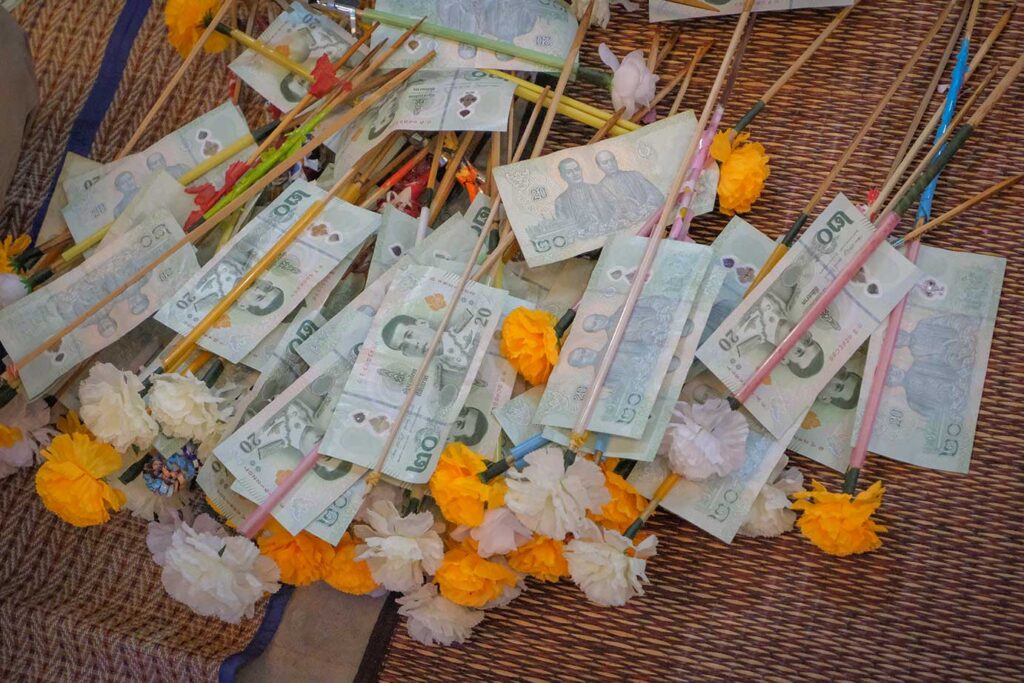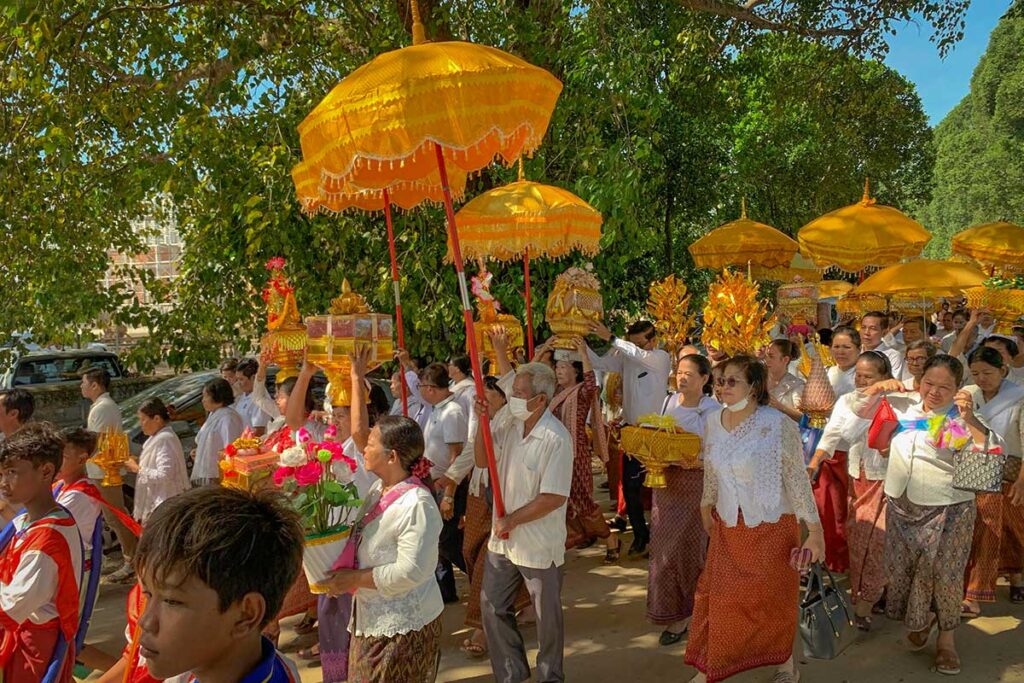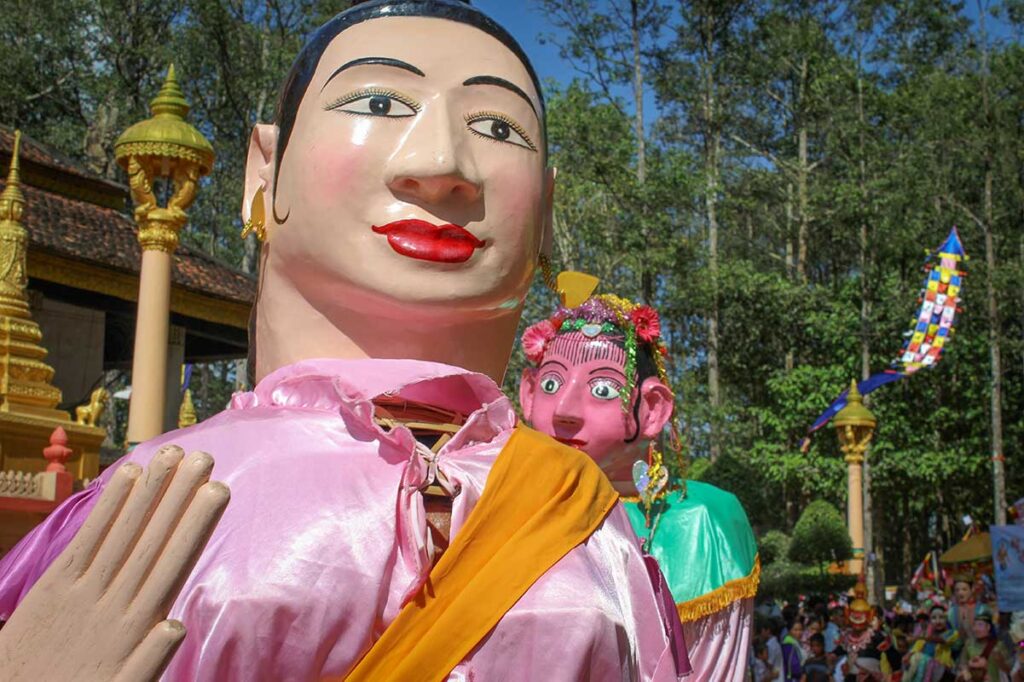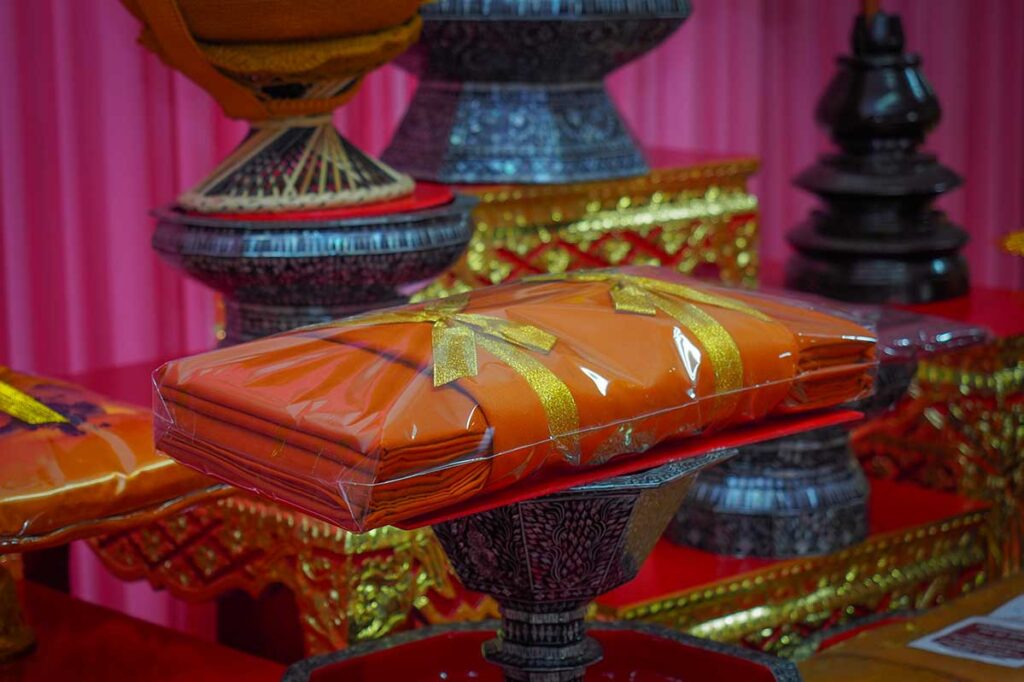What is the Kathina Ceremony?
General meaning and purpose
The Kathina Ceremony is a robe-offering festival in Theravada Buddhism. It is one of the most important annual events for Khmer Buddhists in Vietnam, reflecting both devotion and community spirit. At its heart, the ritual symbolizes generosity and gratitude: laypeople donate new robes and other necessities to monks, believing that the act of giving brings blessings, happiness, and prosperity.

Who celebrates it?
The ceremony is most closely associated with the Khmer ethnic minority in southern Vietnam, where Theravada Buddhism has deep roots. Beyond the Khmer community, Theravada Buddhist followers in other parts of Vietnam also take part, though on a smaller scale. In recent years, events have been held not only in the Mekong Delta but also in central Vietnam (such as Hue) and even in Hanoi at cultural heritage villages.
Why in this region of Vietnam?
The Mekong Delta is home to a large Khmer population, particularly in provinces like Soc Trang, Tra Vinh, and Bac Lieu. For centuries, pagodas in these areas have served not just as places of worship, but as cultural and educational hubs for the community. The Kathina Ceremony continues this tradition, reinforcing the central role of pagodas in Khmer social and spiritual life.
Historical and cultural background
The ceremony traces its origins to the end of the Buddhist Vassa, or rainy-season retreat, when monks spend three months inside the pagoda studying and meditating. Kathina marks the conclusion of this retreat, giving laypeople the chance to support the monks as they prepare to travel again. Over time in Vietnam, the ritual has expanded beyond its purely religious meaning: today it is also a community celebration, often used to raise funds for repairing pagodas, supporting schools, or building local infrastructure, while still keeping the core focus on spiritual merit and the value of giving.
When is the Kathina Ceremony?
The Kathina Ceremony in Vietnam takes place once a year between the 15th day of the 9th lunar month and the 15th day of the 10th lunar month, which usually falls from mid-October to mid-November. The timing marks the end of the Vassa, the three-month rainy-season retreat when monks remain inside the pagoda for study and meditation. Depending on the pagoda and the size of the community, the celebration may last for one day or extend over two days, combining solemn rituals with festive activities.
Where can you witness Kathina in Vietnam?
Southern Vietnam (main region)
The Kathina Ceremony is most vibrant in the Mekong Delta, where the Khmer ethnic community has lived for centuries.
Soc Trang is one of the best-known provinces to experience the festival, with large-scale celebrations at Mahatup (Bat Pagoda), Kh’leang, Som Rong, and Chroi Tum Chas.
Tra Vinh is another key destination, with Ang Pagoda and Chroi Tum Chas among the most prominent venues.
Smaller but equally meaningful ceremonies are held in Bac Lieu, Ca Mau, Hau Giang, and Tay Ninh, where Khmer pagodas remain important cultural centers.
Central Vietnam
Although less common, Kathina ceremonies can also be found in central Vietnam. Hue occasionally hosts events at Theravada pagodas, sometimes supported by international Buddhist communities. A notable example was when the Thai Royal Family organized a Kathina ceremony at Huyen Khong Pagoda, highlighting the shared Buddhist traditions across Southeast Asia.
Northern Vietnam
In northern Vietnam, Kathina is celebrated on a smaller scale but still draws attention, especially at the Culture-Tourism Village of Vietnamese Ethnic Groups in Dong Mo, Hanoi. This venue gathers Khmer monks and lay followers from across the country, allowing Buddhists from northern provinces such as Ha Giang, Lao Cai, and Yen Bai to participate and learn about Theravada traditions more commonly practiced in the south.
What can you see during the Kathina Ceremony?
1. Preparations
In the days leading up to the ceremony, Khmer families prepare offerings ranging from saffron robes—the central gift—to daily necessities such as food, medicine, and household items.

Some communities create money trees, decorated with banknotes and paper flowers, which are carried in processions and later donated to the pagoda. The offerings are arranged with care, often carried on the head as a sign of respect.
2. Rituals and ceremonies

The heart of the event is the robe-offering ritual held inside the pagoda’s main hall. Before entering, devotees and monks walk three times around the pagoda in a clockwise procession. Inside, monks chant prayers, deliver Dharma talks, and bless the participants. Traditionally, the donated cloth is cut and sewn into robes on the same day, a symbolic act that underlines the immediacy and sincerity of the offering.
3. Processions & cultural performances

Kathina ceremonies are as festive as they are solemn. Outside the pagoda, you may encounter Sa Dam drum performances, graceful Robam dances, or even lively Chhan dances with masks and costumes symbolizing the struggle between right and wrong. Colorful processions feature young Khmer women in traditional dress welcoming monks, while villagers carry offerings decorated with flowers and ribbons. These elements add a strong cultural flavor to the religious occasion.
4. Community atmosphere
The atmosphere varies depending on where you attend. In smaller villages, the ceremony feels intimate, with just a few dozen families contributing offerings. At larger pagodas in Soc Trang or Tra Vinh, crowds can reach into the hundreds or more, turning the festival into a major community event. Local authorities often support the celebrations by organizing folk games, cultural performances, or fundraising activities. At its core, the Kathina Ceremony expresses generosity and unity, reinforcing the social bonds of Khmer communities.
5. Food and offerings
Food plays a central role. Devotees prepare vegetarian meals for the pagoda, and a large communal feast follows the morning rituals. Monks eat first, in keeping with Buddhist custom, after which laypeople and guests share in the meal. For visitors, joining this communal dining is a highlight, offering both cultural immersion and a chance to connect with locals.
6. Practical experience for travelers
As a traveler, you’ll notice a contrast between the solemn atmosphere inside the pagoda and the festive mood outside. Larger ceremonies at well-known pagodas in Soc Trang and Tra Vinh attract big crowds, which can be lively but also overwhelming. Smaller rural pagodas may be harder to reach, but they often offer a more authentic and personal experience. For those visiting in late October or early November, it’s possible to combine the Kathina Ceremony with the Ngo Boat Racing Festival, another major Khmer celebration held around the same time.



